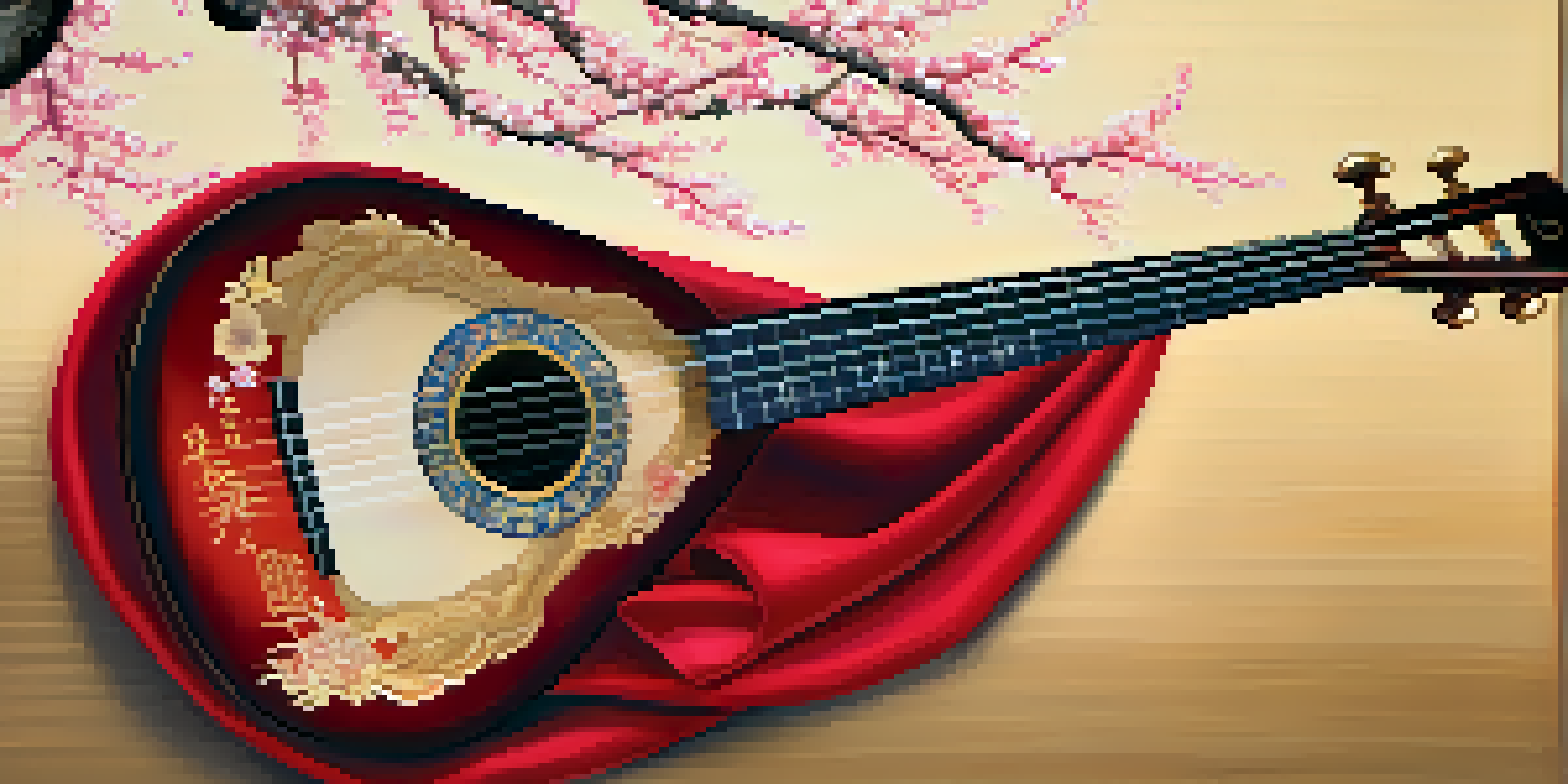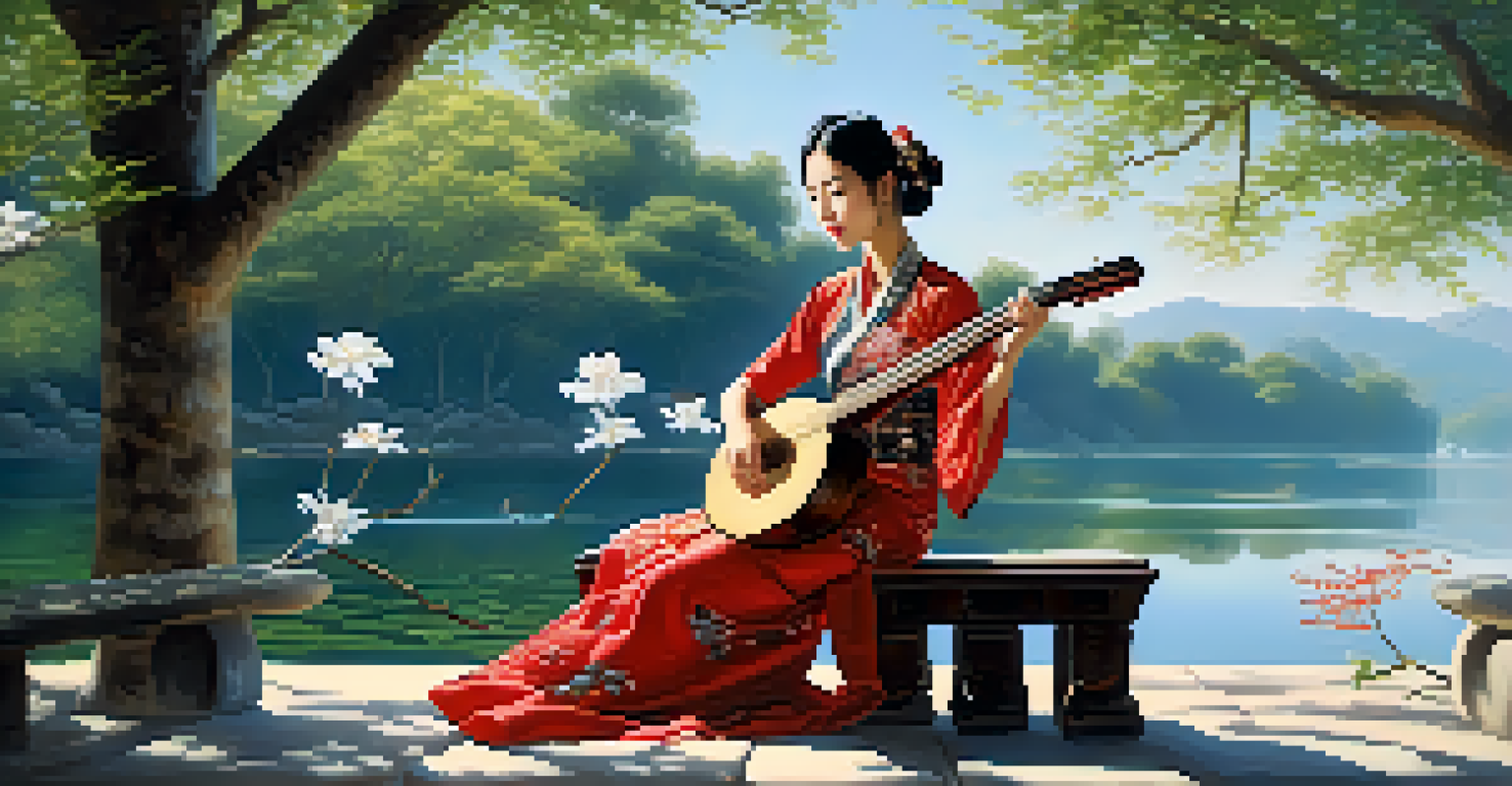The Pipa: A Traditional Chinese Four-Stringed Instrument

The Rich History of the Pipa in Chinese Culture
The Pipa, a four-stringed instrument, has roots that stretch back over 2,000 years in China. Often likened to a lute, it has been a significant part of Chinese music and culture, influencing various traditional art forms. Historical texts and artifacts reveal its presence in royal courts and folk traditions, showcasing its versatility and importance.
Music can change the world because it can change people.
Originally believed to have been introduced to China via the Silk Road, the Pipa evolved as it absorbed influences from different cultures. It has been depicted in ancient paintings and literature, signaling its role in social gatherings and performances. Throughout its history, the Pipa has been a symbol of elegance and sophistication.
Today, the Pipa continues to flourish, with musicians exploring both traditional and contemporary compositions. This adaptability highlights its enduring appeal, bridging the gap between history and modern cultural expression. The Pipa is not just an instrument; it is a living testament to China's rich musical heritage.
Understanding the Unique Structure of the Pipa
The Pipa is distinctive in its construction, featuring a pear-shaped body and a long neck, which is home to four strings typically made of nylon or silk. This unique design allows for a wide range of sounds and playing techniques, making it a favored choice among musicians. The body is often crafted from various woods, adding to its tonal richness.

One of the most striking features of the Pipa is its frets, which are positioned to facilitate intricate finger movements. Players use a combination of techniques such as plucking, strumming, and even bending notes to produce expressive melodies. This versatility makes the Pipa a dynamic instrument that can convey a wide array of emotions.
Pipa's Historical Roots in China
The Pipa, a four-stringed instrument with over 2,000 years of history, has significantly influenced Chinese music and culture.
Musicians often personalize their Pipa, with some opting for decorative elements that reflect their individual style. This blend of artistry and craftsmanship makes each instrument unique, much like the musicians who play them. The Pipa's design not only serves a functional purpose but also enhances its aesthetic appeal.
Mastering the Techniques of Pipa Playing
Playing the Pipa requires a unique set of skills and techniques that can take years to master. Musicians often begin by learning basic plucking patterns and gradually progress to more complex compositions. The dexterity required to navigate the frets and strings is akin to learning a dance, where each movement must be precise yet fluid.
The essence of music is not the notes, but the feelings they evoke.
One popular technique is called 'tremolo,' where players rapidly alternate their fingers to create a shimmering sound that adds depth to the music. Additionally, the Pipa's ability to produce harmonics allows for a diverse range of tones, making it a captivating instrument for both players and listeners. Learning these techniques opens up a world of creative possibilities.
As musicians advance, they often incorporate improvisation into their playing, allowing for personal expression and spontaneity. This element of creativity is what makes the Pipa an exciting instrument to play, as it invites musicians to explore their musical voice. The journey of mastering the Pipa is not just about technique; it is about connecting with the music on a deeper level.
The Pipa's Role in Traditional Chinese Music
In traditional Chinese music ensembles, the Pipa often holds a prominent role, providing both melody and harmony. Its rich sound complements other instruments, such as the erhu and guzheng, creating a harmonious blend that is distinctly Chinese. The Pipa's versatility allows it to adapt to various musical styles, from folk to classical, showcasing its significance in the musical landscape.
During festivals and celebrations, the Pipa is frequently featured in performances, captivating audiences with its enchanting melodies. Musicians often share stories through their music, using the Pipa to evoke emotions and transport listeners to different realms. This storytelling aspect is a crucial element of traditional Chinese culture.
Techniques for Playing the Pipa
Mastering the Pipa requires a unique set of skills, combining intricate finger movements and expressive techniques.
The Pipa is also used in solo performances, where players can fully express their artistry and technical prowess. These solo pieces often highlight the instrument's expressive capabilities, drawing listeners into a mesmerizing experience. As a result, the Pipa continues to be a cherished instrument in both formal and informal settings.
The Pipa in Contemporary Music Scenes
In recent years, the Pipa has found its way into contemporary music genres, bridging the gap between tradition and modernity. Musicians are experimenting with fusion styles, incorporating elements from jazz, rock, and even electronic music. This innovative approach is attracting new audiences and breathing fresh life into the instrument's legacy.
Collaborations between Pipa players and artists from various genres have led to exciting new sounds and compositions. These partnerships showcase the Pipa's adaptability and versatility, proving that traditional instruments can thrive in contemporary contexts. This cross-genre experimentation enriches the global music scene and introduces the Pipa to a wider audience.
Through social media and online platforms, Pipa musicians are gaining recognition and sharing their craft with the world. This accessibility allows for a greater appreciation of the instrument and its cultural significance. As the Pipa continues to evolve, it remains a symbol of China's rich musical heritage while simultaneously embracing modern influences.
Learning to Play the Pipa: Tips and Resources
For those interested in learning to play the Pipa, there are numerous resources available to help you get started. Many music schools offer classes, and online tutorials provide a flexible way to learn at your own pace. Starting with basic techniques and simple melodies can make the learning process enjoyable and rewarding.
Finding a good teacher can make a significant difference in your learning journey. A knowledgeable instructor can provide personalized feedback and guidance, helping you develop your skills more effectively. Additionally, joining a community of Pipa players can offer support and encouragement, making practice more engaging.
Pipa's Role in Modern Music
The Pipa is bridging traditional and contemporary music scenes, inspiring innovative collaborations across various genres.
As you progress, exploring different styles and techniques will enhance your playing experience. Listening to recordings of accomplished Pipa musicians can also inspire you and introduce you to new ideas. Embrace the journey of learning and remember that every musician's path is unique, filled with its own challenges and triumphs.
The Cultural Significance of the Pipa Today
The Pipa is more than just a musical instrument; it embodies the cultural heritage of China. As a symbol of artistic expression, it plays a vital role in preserving traditional music while also adapting to modern influences. This duality reflects the dynamic nature of Chinese culture and its ability to embrace change while honoring its roots.
Cultural events and festivals often feature the Pipa, showcasing its significance in community celebrations. These gatherings provide opportunities for musicians to connect with audiences and share their stories through music. As a result, the Pipa serves as a bridge between generations, fostering a sense of belonging and cultural pride.

Looking to the future, the Pipa's role in both traditional and contemporary contexts will likely continue to evolve. Its enduring popularity speaks to its versatility and the deep emotional connections it fosters among musicians and listeners alike. As we celebrate the Pipa, we honor not just an instrument, but a rich tapestry of history, culture, and artistic expression.